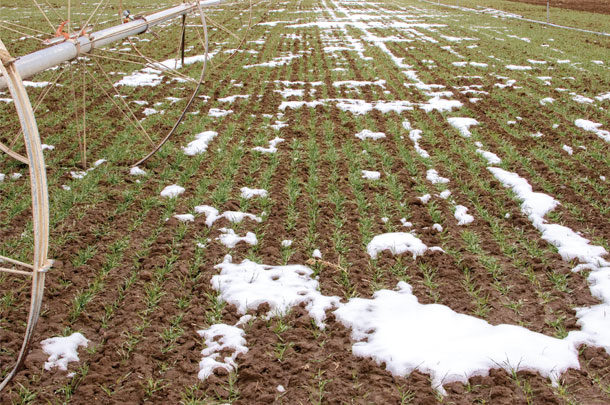Winter forage is a crop that is rapidly increasing across the Northeast, central U.S. and in eastern Canada. It is a winter grain forage specifically grown for high-producing dairy cows in a high-forage diet.
Harvested at flag leaf stage, the NDFd30 omNDF runs 65 to 70, leading some farmers to grow it solely to add to the ration, as the high digestibility can negate “summer slump” production issues. Sugars that are critical to driving high milk protein range from 5% to 7% or more post-fermentation, depending on harvesting as haylage-in-a-day. Yet because the sugar is encapsulated in plant cells, it is a slow release to the rumen to negate any acidosis issues. Sufficient nitrogen with critical sulfur can give forage protein of 20%. This is forage for the high group.
Breaking the low-yield stigma
Unfortunately, some look down on cutting early as a major detriment because of their low yields. They wait for a higher yield at soft dough grain, which is simply straw and grain mix fit for heifers or dry cows. For high-digestible-quality forage for high-producing milk cows in a high-forage diet, the key is to use winter forage management practices, not winter grain practices or cover crop practices. With winter forage management, we have more than doubled flag leaf stage yield to 10 to 14 tons of 35% dry matter (DM) silage that is harvested before the leaves are even on the trees. This early harvest allows for following double crop with corn/sorghum. In an analysis by Cornell University, the worst-case-scenario economic breakeven point was at 5.7 tons of silage (2 tons DM per acre).
The first major problem in growing profitable winter forage is: It is treated either like winter small grains for grain or like a cover crop with minimalist management and inputs. Optimum winter forage is neither. Management for forage is exactly the opposite of that for growing winter grains for grain. Maximizing economic yield takes more effort and thought than throwing out a cover crop and hoping it turns green. The irony is: Properly managed, winter forage is like a cover crop on steroids. Maximizing fall biomass increases the protection of the soil from erosion, retains more nutrients and increases soil biological activity by root exudates. All these benefits and you harvest an economical, profitable high-quality forage.
The preferred winter forage is winter triticale. It is far higher-yielding than winter wheat. In replicated trials compared to winter rye, the triticale has the same yield. A major advantage of triticale is: It is a shorter, tiller dense crop, which can stand even at nitrogen rates that support 20% crude protein (CP). Rye at that fertilization level was flat on the ground. Newer triticale varieties are at flag leaf almost as early as rye. Triticale, if planted the critical 1.25 inches deep, overwinters with little or no issues, especially if it is planted on time.
Updated management
The first management change is the planting date. For high yields, the seed must be in the ground two weeks before the normal planting date for wheat in your region. The later we planted, the less forage we had next spring, the more susceptible it is to winterkill, the later it comes off in spring, the less cover crop benefit accrues. Now we still had economical yields planting four weeks late – but like corn, the best yield is planted on time. As we planted earlier, the number of tillers formed before winter increased. More tillers meant more potential forage yield the next spring. Winter grain production is to maximize head size. For winter forage, we maximize the number of stems in the spring with no regard to head size.
If you are forced to plant late, in our trials there was no yield increase to pay for the seeding rate above 100 pounds per acre. What we have found is: Three-way fungicide seed treatments on the winter forage gave excellent results. Where we planted on time, the seed treatment increased spring forage yield 15%. Planted late, the use of the seed treatment increased spring forage yield by 28% compared to none.
Most farms are grossly under-fertilizing the crop. A typical New York yield is over 3 tons of DM per acre. Yield potential increases as you move south. At 20% crude protein, that is removing 192 pounds of nitrogen per acre. No fertilizer in the fall and 100 pounds of nitrogen in the spring will neither maximize yield nor crude protein in the forage. Additionally, using only nitrogen without sulfur will hold protein to less than 15%. Sulfur (10 nitrogen to 1 sulfur) is critical to reaching 20% CP. Our research found that we were able to increase spring forage yield by applying up to 60 pounds of nitrogen per acre of fall nitrogen and sulfur to increase the number of tillers.
Planting early with nitrogen to get maximum tillers and high fall biomass (which also protects the crowns from harsh winter) will not produce a mass of vegetation that will smother. We have tested a wide range of planting dates and fall nitrogen rates with no loss from either factor. What does occur is: When there is a winter thaw, water collects on depressions in the frozen ground, and snow mold disease can devastate the crop in those spots regardless of plant date or fertilization.
We discourage top-dress manure on the winter forage in late fall or early spring due to compaction, loss of more than 50% of the nitrogen and potentially disastrous to spring silage, as the manure is entrained in the vegetation of the plant. Very highly digestible forage with high sugar and protein harvested with entrained top-dress manure (it lasts over winter) becomes a horrible-smelling, cow-killing, maggot-filled ensiled mess. Been there, done that, don’t do it.
Proven practices
What has worked is where we used a donated Bazooka wavy coulter manure injector and went into 10-inch-tall winter triticale the last week of November (works until the ground freezes). The wavy coulter did not smear the sides, so the soil quickly absorbed the liquid and captured all the nitrogen that would have been lost (tripling that available to the triticale). The manure nitrogen remained in the ammonia form, which does not leach. When the ground warms in the spring, the winter forage quickly grabs the nitrogen and utilizes it for growth and protein. Thus, we can both supply the crop’s nitrogen and unload manure off-season in an environmentally sound system.
It is critical that harvest is targeted at flag leaf stage (the last leaf is out but the head has not emerged). For dairy production, we need high digestibility both to support high milk production and herd health. Flag leaf is the balance of maximum quality and yield. This quality must be still there when the forage reaches the mouth of the cow.
Three steps to success
Three critical steps are first, to use a wide swath (swath more than 80% of cutter bar) without the conditioning that is counterproductive for photosynthetic drying. Mowing directly to a narrow swath is simply windrow compost drying and burns off much of the digestible components through plant respiration before the crop is dry enough to ensile. A wide swath without conditioning exposes the leaves to sunlight, so natural photosynthesis rapidly utilizes the water in the plant and converts it to highly digestible sugar and starch, simultaneously increasing quality and drying the crop.
The second step is to use a tedder. With yields three times more than the heaviest first-cutting alfalfa, photosynthetic drying will only dry the top layers. After two hours, the top layers get too dry for photosynthesis (greater than 45% DM) and by carefully tedding, the lower layers are exposed to the sun for continued photosynthetic drying. This dries the entire crop for ensiling the same day it is mowed. Leaving a crop overnight is discouraged, as it will respire away much of the milk-producing digestible material (unless night temperatures drop into the 30s).
The final critical step is to use a high-quality inoculant on the silage. On a similar forage (wetter, high-sugar-BMR sorghum), the difference between the control and the inoculated was equal to 2.3 pounds of milk per cow per day from preserved digestibility.










